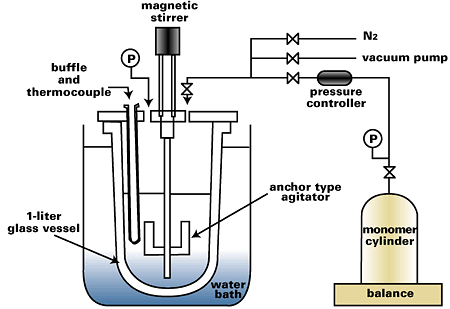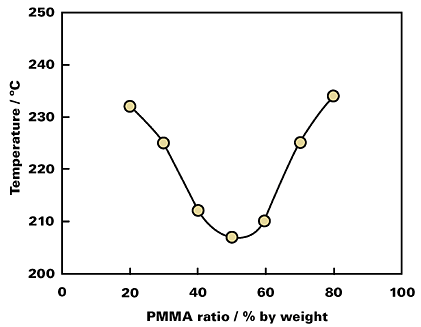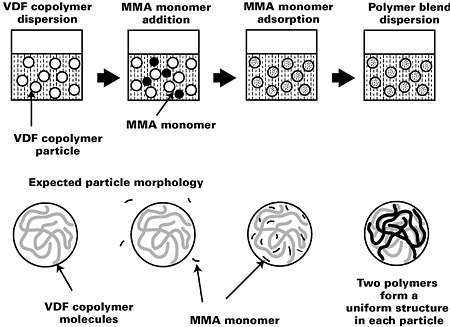
Environmental consciousness, however, has led to restrictions on some chemical compounds. The removal or reduction of VOCs from paint formulations is one of the most serious problems the paint industry faces today. Tremendous effort has been made to replace conventional solventborne paints with high-solids, waterborne and powder coatings.
Without sacrificing the excellent performance of the combination of VDF copolymer and MMA, we have sought to apply this system to waterborne paints in a formulation compatible with a range of colors and gloss, at ambient temperature, and using only a small amount of coalescent agent. Figure 1 shows our VDF polymer development downstream.

To obtain the complete VDF copolymer/PMMA mixture, the seed polymerization technique is one approach. Some trials have been made to develop this type of polymer mixture,2-4 but investigations in this field have been few.
Another important factor to consider when applying this system for waterborne coatings is surfactant control. In emulsion polymerization systems, surfactants play important roles such as maintaining the polymer particle stability and controlling the particle size. Hence, the choice and amount of surfactants significantly affects coating film performance. For example, improper surfactant choice may lead to foaming, which in turn causes surface defects and decreased water resistance. Also, previous work suggests that in the case of seed polymerization, the amount of the surfactants is the key factor to control new particle generation.5 From this point of view, it is crucial to prepare the VDF copolymer dispersion of small particle size and high concentration as seed in the presence of only a small amount of surfactants.

Emulsion Polymerization of the VDF Copolymer
PVDF or VDF copolymers can be made by using either an emulsion or a dispersion process. The emulsion polymerization is carried out as follows. After charging the deionized water and surfactants in a pressure vessel, the vessel is pressurized at a constant temperature with gas state fluoromonomers. Choice of temperature is important. Then, after charging the initiator, the monomer is supplied gradually such that the pressure inside of the vessel is kept within a reaction-sustaining range. In these experiments, we used a one-liter glass pressure vessel equipped with an anchor-type stirrer. Perfluorooctanoic acid ammonium salt (PFOA) was used as a fluorosurfactant. After charging 500 mL of deionized water and an amount of PFOA, the reactor was pressurized to 1.0 MPa at 60ºC or 80ºC with the monomer mixture. Here again, choice of the mixture ratio is important. Then 10% by weight of ammonium peroxodisulfate (APS) was added to initiate the reaction. As the reaction proceeded, the VDF monomer mixture was supplied to keep the pressure at 1.0 MPa. The polymerization reactor scheme is shown in Figure 2.

Relationship Between Polymer Composition and Emulsion Polymerization Stability
Vinylidene fluoride (VDF) and tetrafluoroethylene (TFE) are copolymerizable across the entire composition range. The copolymers show the minimum melting point and crystallinity at the TFE ratio of 20 mol%. Additionally, by introducing relatively bulky fluoroolefins such as hexafluoropropylene (HFP) or chlorotrifluoroethylene (CTFE), the melting point and crystallinity decrease. Previous work6suggests that in the VDF-TFE-based copolymer system, there is a close relationship between polymer composition and emulsion polymerization stability. To avoid the effect of the surfactants, we polymerized a series of VDF-TFE copolymers with soap-free emulsion polymerization using APS initiating systems. We found that with the increase of the crystallinity, the shapes of the particles tend to become angular and the stability of the polymer dispersion decreases. Table 1 shows that with the increase of the crystallinity, the maximum attainable polymer concentration (Mp MAX) decreases.

Particle Number Control by Nonfluorinated Surfactant
For radical polymerization of VDF copolymers, the presence of the hydrocarbon compounds, including surfactants, leads to chain-transfer. As a result, polymerization speed decreases and high-molecular-weight polymers cannot be obtained. Because of this, fluorosurfactants — which have a fluorocarbon hydrophobic group and an ionic hydrophilic group — are preferably used for the emulsion polymerization of VDF copolymers.In this emulsion polymerization system, the number of the precursors is assumed to increase until the precipitation occurs. The particle number is then fixed. The timing of the particle number settlement is assumed to be the point where Mp is around 50 g/L. After this stage, the number of particles is almost constant, which suggests the growth of each particle with the increase of the Mp. As a result, this dispersion shows monodispersity. In this system, the number of the particles increases with increased emulsifier concentration, and no critical point can be observed at the critical micelle concentration (CMC) of the surfactants.7
Table 2 shows the relationship between the emulsifier concentration and the number of the polymer particles. The effect of the coexistence of non-fluorinated surfactants is also shown. In the presence of non-fluorinated surfactants, except for the fatty acid polyoxyethylene ester type, critical polymerization speed decreases were observed. On the other hand, in the presence of the fatty acid polyoxyethylene ester-type surfactants, critical particle number increases were observed and the effects on the polymerization rate were rather small. This is because, as a result of the chain-transfer reaction of the precursors to the hydrocarbon surfactants, which have the hydrophilic polyoxyethylene groups, the precursors become more stable and the precipitating concentration increases. Hence there would be more chance for the new precursors to be generated. We have tried to detect the water-soluble precursors at the very early stages of the polymerization using HPLC. In the presence of non-fluorinated surfactants, water-soluble fractions are observed that cannot be detected with the fluorinated surfactant systems.8


Miscibility of VDF Copolymer and MMA Polymer
Of the miscible polymer blends, that of PVDF and PMMA has received the most technical attention. VDF/TFE copolymer is also reported to be miscible with PMMA and its LCST type phase diagram has been observed.9We have confirmed in a differential scanning calorimeter (DSC) that p(VDF/TFE/CTFE) and PMMA solution blends show the melting point depressions of the terpolymer at the 8/2, and single glass-transition temperatures at the mixing ratio between 7/3 and 2/8 by weight. The phase separation enthalpy is observed at the temperature range of 200–260ºC.10The phase diagram in which those clouding points are plotted as the function of the mixing ratio is shown in Figure 4. Like other VDF polymers, the system shows the LCST-type phase diagram.
Seed Polymerization
As shown in Figure 5, our purpose is to prepare a polymer dispersion in which the VDF polymer and PMMA are mixed at the molecular level in each particle. For “seed” dispersion, the VDF/TFE/CTFE terpolymer dispersion obtained above was used. After adding the surfactant, MMA monomer emulsion was added and adsorbed, then APS was added and polymerization was carried out at 80ºC for 3 hours.
A typical electron micrograph of VDF terpolymer PMMA seed polymer latex on a transmission electron microscopy (TEM) is shown in Figure 6. The latex size distribution was relatively monodispersive and secondary particle generation was not observed. The latex size distribution was determined by sizing about 200 particles.
A differential scanning calorimeter was used to examine the miscibility of the seeded latex.
To obviate the effect of the heat cycle to the polymer phase condition, the latex was dried below the polymerizing temperature. The DSC diagram is shown in Figure 7.

Film Performance
By combining these techniques, we have introduced fluoropolymer dispersions for coatings, the ZEFFLE SE series in the market. With careful selection of the surfactants and the optimization of the polymer composition and molecular weight, good film formability, good water resistance and excellent weather resistance are balanced at a prominent level. A typical formulation example is shown in Table 4.Weatherability
Waterborne paints generally show inferior performance when compared to solventbornes with the same polymer system. This is assumed to come from the surfactants used for stabilizing the polymer dispersion or from film-forming defects attributable to the process of the emulsion-type paint. This paint system, however, shows outstanding resistance to climatic factors such as moisture, extremes of temperature and ultraviolet radiation. This performance comes from the fact that VDF copolymer and PMMA are mixed at the molecular level in each particle. Such performance cannot be attained with simple dispersion blends.It is assumed that, as a result of the strong interaction between the ester groups of PMMA and the dipole of PVDF units, the relatively weak ester groups of the PMMA structure will be protected by the PVDF.
Various kinds of accelerated weathering tests have been proposed, aimed at evaluating long-term environmental effects in a short time. We have found that the data from the carbon arc weatherometer showed relatively good correlation with natural weathering. With this instrument, the effect of the VDF polymer concentration on the systems and the pigment surface treatment can be predicted. Because the acceleration rates for different kinds of resins are not constant, care must be taken in evaluation.
Figure 8 shows the test result of the carbon arc weatherometer. When compared with solventborne PVDF coatings, no significant difference could be observed.
In spite of the efficiency of accelerated weathering instruments, they have limitations. This fact must be recognized and the results interpreted considering the natural weathering results.
We are carrying out an exposure test on Miyakojima Island, at the southern edge of the Japan archipelago. The island belongs to the sub-tropical region, and is a good place for natural weathering with its abundance of humidity, sunshine, and heat. Comparison data has shown that weathering conditions in Miyakojima using a 30º south inclination are no less severe than that of south Florida using a 45º south inclination.
White paint surfaces exposed in Miyakojima at 30º south for 5 years were evaluated by gloss change, color change, scanning electron microscopy (SEM) observation and FT-IR scanning.
As shown in Figures 9–10, the seeded polymer coating demonstrates excellent gloss retention and small color change in contrast to waterborne acrylic and solventborne acrylic urethane coatings that show pronounced gloss and color change.


Conclusion
By the seed polymerization technique, a polymer mixture of VDF copolymer and PMMA at molecular levels can be prepared. DSC techniques demonstrated that this system exhibits the single glass-transition temperature and LCST type phase diagram.The paint film obtained from this seeded latex showed excellent weather resistance both in the accelerated weathering test and natural exposure.
This article is based on a paper presented at Fluorine in Coatings III.
For more information on fluropolymer emulsions, contact Daikin Industries Ltd., 1-1 Nishi-Hitotsuya, Settsu-Shi, Osaka, Japan; phone +81/6.349.1922; fax +81/.6.349.7393; e-mail ntsuda@notes.che.daikin.co.jp.



